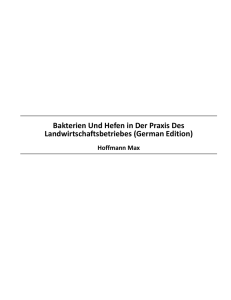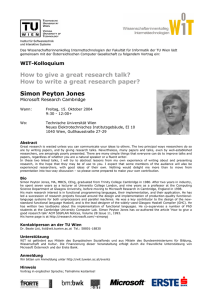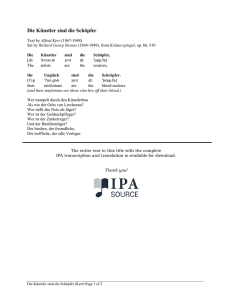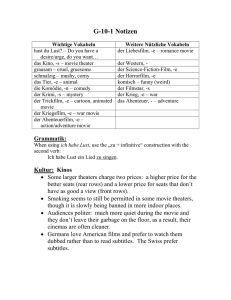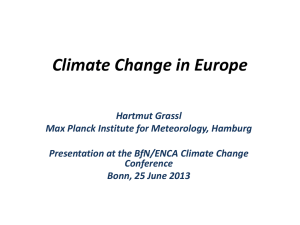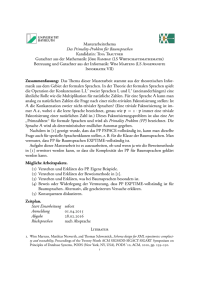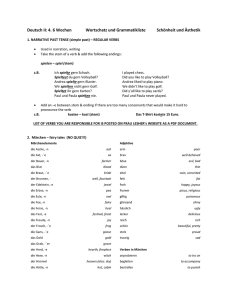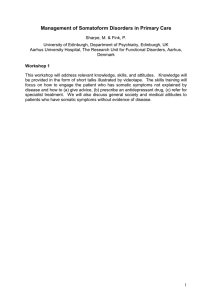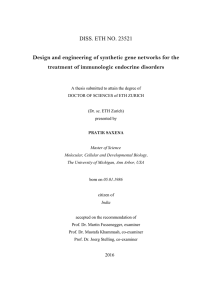Climate Change - Challenges
Werbung
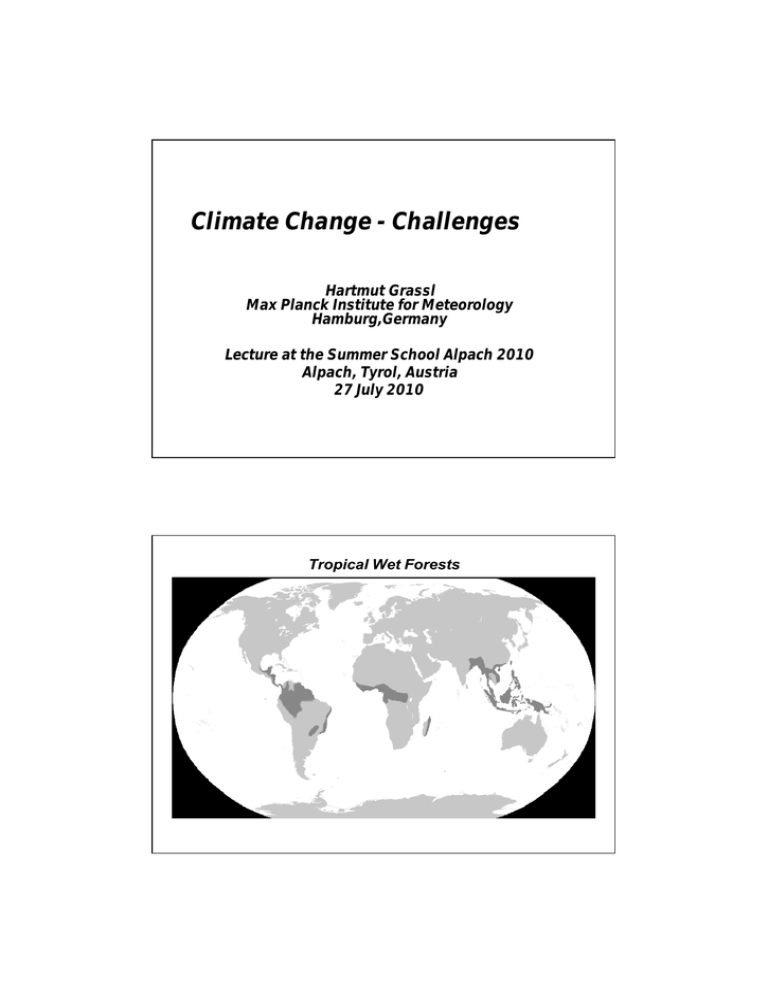
Climate Change - Challenges Hartmut Grassl Max Planck Institute for Meteorology Hamburg,Germany Lecture at the Summer School Alpach 2010 Alpach, Tyrol, Austria 27 July 2010 Tropical Wet Forests Tropical Rainforest near Cairns , Australia Tundra in Alaska An ideal glacier terminus: Where is it? Idealtypus eines Gletschertores: Wo ist es? Answer: At 830 m above mean sea level in the Alps (close to Königssee in Bavaria) • An extreme example of local climate deviating from the regional mean, which would nourish a beech forest at this place • Local future climate change will be very difficult to project if regional climate change is characterized by changed mean flow What is Climate? • Climate is the synthesis of weather over at least 30 years (definition by WMO) • Mean values plus the probability distributions of the deviations from the mean for all climate parameters (CO2 concentration is one) in the atmosphere, at the surface and in the ocean • The most important natural resource Climate Factors (roughly ranked) •Spectral solar irradiation •Size of the planet •Composition of the atmosphere •Earth orbit around the Sun •Vegetation properties including emissions of trace gases and oxygen •Distribution of continents •Impact of celestial bodies •Internal interactions of the earth system components •Volcanic eruptions • Time Scales of Climate From half anProcesses hour for mixing in the convective planetary boundary layer to many millions of years for systematic changes of solar irradiance • Examples for time-scales: -Turnover time of the global ocean: ˜ 1 ky - Earth orbital parameter changes: From 19 ky to 450 ky, quasi-periodic - Turnover time of big ice-sheets: ˜ 10 ky - from one glacial maximum to the next: ˜ 100 ky Gefahren für die Ökosysteme der Erde durch den homo sapiens Are we already outside a tolerable anthropogenic change? Nature, September 2009 Green: tolerable; Red: surmounted Geschätzte Grenzwerte THE KEY CHALLENGE OF ANTHROPOGENIC CLIMATE CHANGE: Climate change rate is by a factor of at least 40 faster in the 21st century than the natural global climate change rate during the last million years; it could reach a factor of 100 without globally co ordinated climate change policies Next Section: Observed Climate Parameters (with focus on new satellite data) •Means •Variability •Trends Nettosüßwasserfluss 18 Jahresmittel (18 year average) Blitzhäufigkeit (Courtesy of NASA) Störung und Unsicherheit im globalen Kohlenstoffkreislauf Disturbances and Uncertainties in the Global Carbon Cycle Hauptunsicherheit Main Uncertainty Mittlerer Methansäulengehalt Änderung bei langen Zeitreihen der Lufttemperatur, des Meeresspiegels und der Schneebedeckung (letzteres nur in der nördlichen Erdhälfte) black: 10 year moving average; blue: standard deviation; circles: global yearly averages Satellites March, April IPCC4 WG I, 2007 18 IPCC4 WG I, 2007 Cumulative mean specific mass balances (a) and cumulative total mass balances (b) of glaciers and ice caps, calculated for large regions (Dyurgerov and Meier, 2005). Mean specific mass balance shows the strength of climate change in the respective region. Total mass balance is the contribution from each region to sea level rise. Observed Global Sea Level Rise Source: The Changing Earth (SP-1304, ESA, 2006) sea level rise derived from several satellite altimeters Meeresspiegelanstieg in der Satellitenära seit 1992 Next section: Climate Change Projections • • • • Development of climate models Global mean warming projections Regional precipitation changes Dangerous climate change Entwicklung der globalen Klimamodelle 1990 2001 1995 2007 Mittlere globale Erwärmung Mit Klimamodellen errechnete mittlere Erwärmung an der Erdoberfläche (Modellmittel und Unsicherheitsbereiche der Klimamodelle) EU,G8,G20 , Kopenhagen-Ziel----------------------------- ----------------------------------------------------------------------- never experienced by homo sapiens IPCC- AR4, 2007.1 Geänderte Niederschlagsmuster Stippled: 90% of models agree White: no significant changes in 60% of all models In other words: Those with enough water get more, people with scarce water resources get less SST changes 21C - 20 C Courtesy of: Lennart Bengtsson, 2006 Storm track intensity and density ECHAM5 and ERA 40 (MJJASO) Courtesy of: Lennart Bengtsson, 2006 IPCC 2001 PNAS 2009 Rapid Anthropogenic Climate Change Rascher Klimawandel durch den Menschen EU Goal---------------------------------------------------------------------------------------- Hartmut Grassl Max Planck Institut for Meteorology, Hamburg Reykjavik, 9 July 2009 „The understanding of anthropogenic warming and cooling influences on climate has improved since the Third Assessment Report, leading to very high confidence that the global net effect of human activities since 1750 has been one of warming, with a radiative forcing of 1.6 (+0.6 to 2.4)Wm-2.“ IPCC, WG1, SPM (2007a) „Approximately 20-30% of plant and animal species assessed so far are likely to be at increased risk of extinction if increases in global average temperature exceed 1.5-2.5 oC.“ IPCC, WG2, SPM (2007b) Categories of a dangerous interference with the climate system •Determinative dangers are, on their own, enough to define dangerous levels of climate change. The European Climate Forum ( ECF) list of determinative dangers resulting from climate change include: circumstances that could lead to global and unprecedented consequences, extinction of “iconic” species or loss of entire ecosystems, loss of human cultures, water resource threats, and substantial increases in mortality levels, among others. • Early warning dangers are dangers already present in certain areas that are likely to spread and worsen over time with increased warming. These dangers could include Arctic Sea ice retreat, boreal forest fires, and increases in frequency of drought, and they could become determinative over time or taken together with other dangers. • Regional dangers are widespread dangers over a large region, most likely related to food security, water resources, infrastructure, or ecosystems. They are not considered determinative, as they are largely confined to a single region. The Framework Convention on Climate Change (UNFCCC) calls for stabilization of greenhouse gases to “prevent a dangerous anthropogenic interference with the climate system ”. UNFCCC further suggests that: “Such a level should be achieved within a time frame sufficient • to allow ecosystems to adapt naturally to climate change; • to ensure that food production is not threatened; and • to enable economic development to proceed in a sustainable manner. However the UNFCCC never defined what it meant by “dangerous”. Die Rahmenkonvention der Vereinten Nationen über Klimaänderungen (UNFCCC) fordert die Stabilisierung der Treibhausgaskonzentrationen um einen gefährlichen Eingriff in das Klimasystem zu vermeiden. Weiterhin fordert sie, dass ein solches Konzentrationsniveau innerhalb eines Zeitrahmens erreicht werden soll, der •die Anpassungsfähigkeit der Ökosysteme erhält •die Nahrungsproduktion nicht gefährdet und •eine nachhaltige wirtschaftliche Entwicklung erlaubt. Ein gefährlicher Eingriff ist jedoch bisher von UNFCCC nicht definiert The 2°C goal, i.e. warming below 2°C at the end of the 21st century in comparison to the preindustrial level, taken note of at COP 15 in Copenhagen, can neither quarantee the further existence of large parts of the Greenland ice sheet nor the major damage to coral reefs Although there is finally a goal set by the United Nations a growing number of scientists see no prevention of a dangerous anthropogenic interference with the climate system 2°C in terms of allowed emissions Meinshagen et al.) (Nature 2009, (C = CO2/3.67) WBGU 2009: only 750 Gt CO2 allowed until 2050 Herausforderung The Climate Change Challenge Klimawandel 1. Das Unbeherrschbare vermeiden 2. Das Unvermeidbare beherrschen 1. Avoiding the unmanageable 2. Managing the unavoidable (Schellnhuber)

